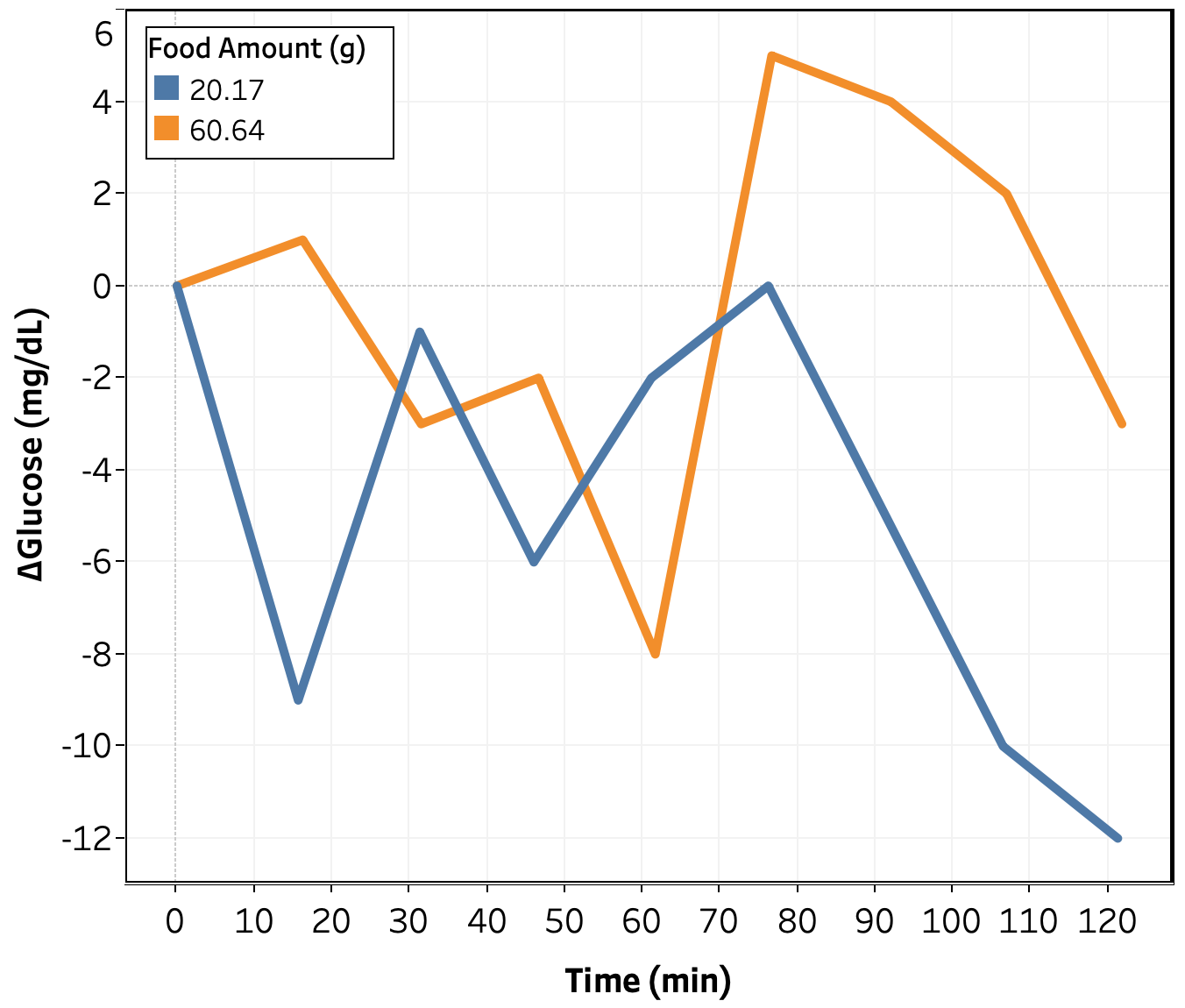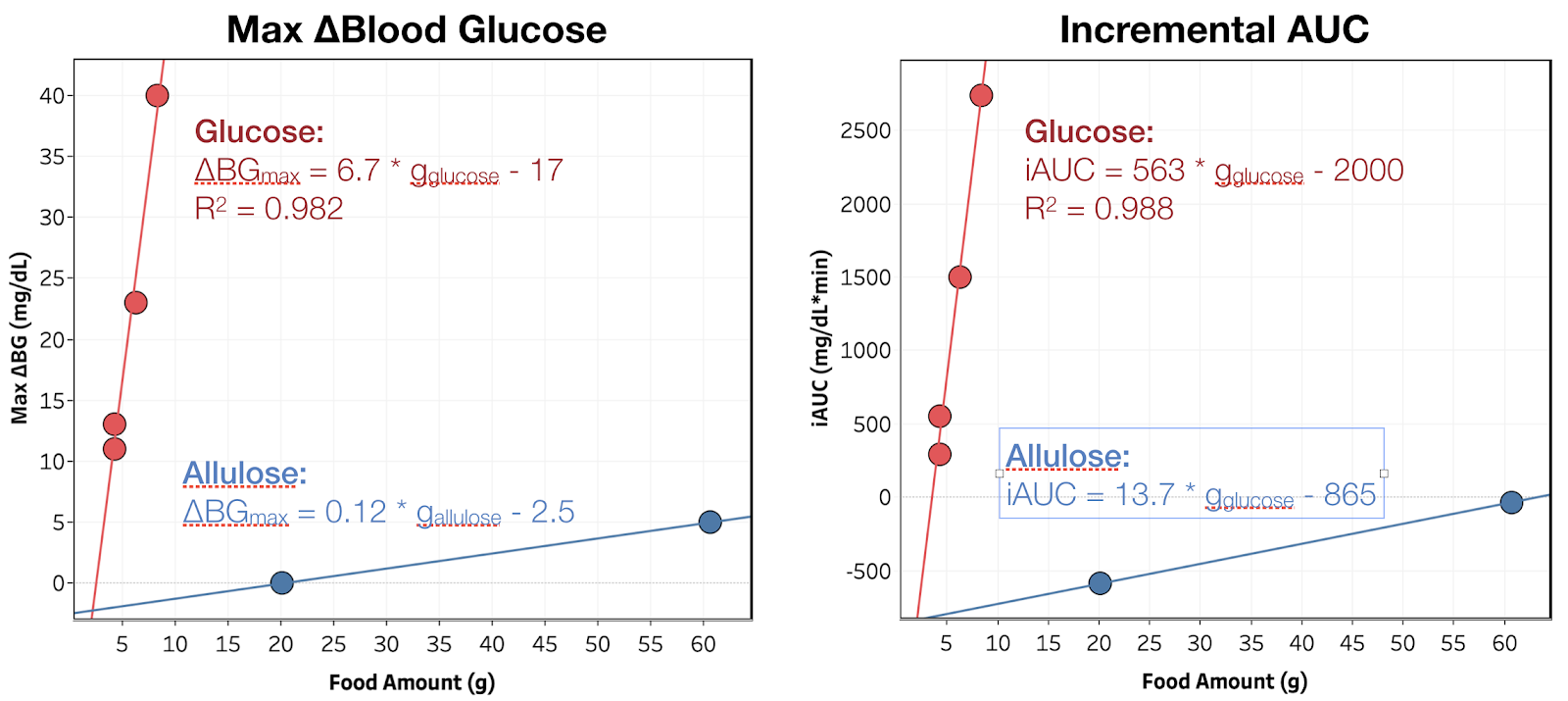Get new posts by email or rss feed
This self-experiment is being done as part of the Keating Memorial Self-Research Project. A couple of other people from the Open Humans community are also running the same experiments. If you’re interested in joining in, let me know in the comments or send me a PM.
This post is an update on my experiments measuring the effect of food ingredients on blood sugar.
Plan:
- Design experiments and solicit feedback: blog, Reddit, OpenHumans
- Calibrate continuous blood glucose meter: started 2/18, report tbd.
- Establish fasting baseline & determine time of day for experiments: Complete
- Food effect measurements
- Glucose: Complete
- Allulose: Complete (this post)
- Oat fiber: started 3/13
- Whey protein
- Oat fiber, cooked
- Resistant starch
- Tapioca fiber
- Lupin flour
This week, I have the results from allulose and got started on oat fiber.
Summary
Allulose has a negligible effect on my blood sugar, <0.1 mg/dL/g(allulose), or <2% that of glucose.
Details
Purpose
To quantify the effect of ingestion of food ingredients and ingredient combinations on my blood sugar.
Ingredient Background
Allulose is a sugar substitute with very similar physical properties to table sugar. This makes it particularly useful in low carb baking or any recipe where sugar provides texture as well as taste. I personally have found it particularly useful for making ice cream, cookies, and syrup.
Design/Methods
Procedure. From 7 pm the day before through 4:30p the day of experiment, no food or calorie-containing drinks were consumed and no exercise was performed. Non-calorie-containing drinks were consumed as desired (water, caffeine-free tea, and decaffeinated coffee). At ~12 pm, the substance to be tested was dissolved or suspended in 475 mL of water and ingested as rapidly as comfortable. BGM measurements were then taken approximately every 15 min. for 2 h or until blood glucose had returned to baseline, whichever was longer. A final BGM measurement was taken 4.5 h after ingestion.
Measurements. Blood glucose was measured using a FreeStyle Libre flash glucose monitor and a FreeStyle Freedom Lite glucose meter with FreeStyle lancets & test strips. No special precautions were taken to clean the lancing site before measurement. To take a sample, the lancing devices was used to pierce the skin at an ~45 deg. angle from the finger. Blood was then squeezed out by running the thumb and pointer finger of the opposite hand from the first knuckle to the lancing site of the finger. Blood was then wicked into a test strip that had been inserted into the meter and the glucose reading was recorded.
Data Processing & Visualization. iAUC was calculated using the trapezoid method (see data spreadsheet for details). Data was visualized using Tableau.
Medication. I took my normal morning and evening medication, but did not dose for the experimental food ingested.
Data
Results & Discussion

Change in blood glucose as a function of time for the allulose tests is shown in Figure 1. Qualitatively, there appears to be no impact of allulose up to 60 g consumed, with the possible exception of a small around 75 min.

To better quantify the impact of glucose on my blood glucose, I plotted the maximum increase in blood glucose and the iAUC of blood glucose (incremental area under the curve) vs. amount consumed for both glucose and allulose (see Figure 2). While the allulose data shows an increase in both blood glucose and iAUC as a function of amount consumed, there’s only two data points and the magnitude is extremely small and could easily be due to experimental error. Confirming this effect would require running more allulose measurements. I may go back and do this later, but for the moment, I would prefer to focus my time on ingredients with unknown or more substantial effects.
Lastly, I continue to observe a large negative intercept, suggesting a background drop in blood sugar during the experimental window.
Conclusion & Next Experiments
Allulose has a negligible effect on my blood sugar, <0.1 mg/dL/g(allulose), or <2% that of glucose. This week, I will measure the effect of oat fiber, a zero calorie, zero digestible carbohydrate flour replacement.
– QD

These trials are amazing! Thanks!
A decrease of blood glucose levels improves insulin affectability by making it more viable.Novolin Vials